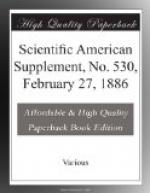by machinery to shake down the mixture and to get
rid of air holes. While it is still wet the casting
is taken out of the mould, its edges are cleaned,
and after the lapse of one day it is placed in a bath,
of silicate of soda. Should the casting be allowed
to get dry before it is placed in this bath, no good
results would be obtained; it is left in the bath
for seven days. When delicate stone carvings
have to be copied, the moulds are of a compound of
gelatine, from the flexible nature of which material
designs much undercut can be reproduced. For
the foregoing particulars we are indebted to Mr. William
Millar, the working manager at West Kensington.
Sometimes the composition is cast in large, heavy
slabs, moulded on the top to resemble the surface
of roads of granite blocks. A feature of the
invention is the rapidity with which the composition
sets. For instance, the manager states that a
roadway was finished at the Inventions Exhibition
at seven o’clock one night, and at six o’clock
next morning four or five tons of paper in vans passed
over it into the building, without doing any harm
to the new road. In laying down roads, much of
the preparation of the material is done on the spot,
and the composition after being put down unsilicated
in a large layer has the required design stamped upon
its wet surface by means of wooden or gutta-percha
moulds. As regards the durability of the composition,
Mr. T. Grover, one of the directors, says that the
company guarantees its paving work for ten years,
and that the paving, the whole of the ornamental tracings,
and some of the other work at Upton Church, Forest
Gate, Essex, were executed by means of Wilkes’
metallic cement three years ago, and will now bear
examination as to its resistance to the action of weather.
Some of this paving has been down in Oxford Street,
London, for more than six years. Mr. A.R.
Robinson, C.E., London agent of the company, states
that the North Metropolitan Tramway Company has about
25,000 yards of it in use at the present time, and
that the paving is largely used by the War Office
for cavalry stables. The latter is a good test,
for paving for stables must be non-slippery and have
good power of resisting chemical action.
In the Wm. Millar and Christian Fair Nichols patent
for “Improvements in the means of accelerating
the setting and hardening of cements,” they
take advantage of the hydraulicity of certain of the
salts of magnesia, by which the cements set hard and
quickly while wet. For accelerating the setting
of cements they use carbonate of soda, alum, and carbonate
of ammonia; for indurating or increasing the hardening
properties of cements they use chloride of calcium,
oxide of magnesia, and chloride of magnesia or bittern
water; for obtaining an intense hardness they use oxychloride
of magnesia. The inventors do not bind themselves
to any fixed proportions, but give the following as
the best within their knowledge. For colored
concretes for casts or other purposes they use Carbonate




